Community Forum
Horse World Online
Breed horses and ponies, raise your foals, and train the next champion in this exciting and realistic online horse breeding game.
The new layout is in beta testing and we're inviting you to help us try it out! Click here to read the announcement post for details.
Plume?
Forum rules
You can link to a horse using our new custom BBCode:
[horse=1234]Horses Name[/horse]
This will display the most recent photo of the horse as well as a link to him.
You can link to a horse using our new custom BBCode:
[horse=1234]Horses Name[/horse]
This will display the most recent photo of the horse as well as a link to him.
-
Stick
- Posts: 132
- Joined: Sun May 14, 2017 3:16 pm
- Visit My Farm
Plume?
Post by Stick »
I know that "plume" is sort of a newly-researched gene and that the discussion is still ongoing, but maybe someone can answer this for me anyway. Does this guy seem to be displaying the plume gene in his mane/tail, or is there some other effect making it look strange? I have much more obvious examples of it in my herd, but I'm not sure with this particular guy. Since his mane seemed to be pale even at birth, I don't think it's the LP varnish doing it, and I waited until his first birthday to see if it would disappear, but it seems to be sticking around. I tried to take a few close-up shots as he aged, so it's easier to see in his gallery.
Any thoughts on this guy?
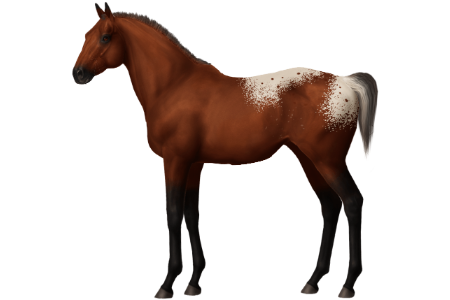
Any thoughts on this guy?

-
BlackOak2
- Premium

- Posts: 10573
- Joined: Sat Jan 30, 2016 12:41 am
- Visit My Farm
Re: Plume?
Post by BlackOak2 »
In my limited opinion, it is possible that it's plume, however, when dealing with Lp, it's more possible that it's Lp.Stick wrote:I know that "plume" is sort of a newly-researched gene and that the discussion is still ongoing, but maybe someone can answer this for me anyway. Does this guy seem to be displaying the plume gene in his mane/tail, or is there some other effect making it look strange? I have much more obvious examples of it in my herd, but I'm not sure with this particular guy. Since his mane seemed to be pale even at birth, I don't think it's the LP varnish doing it, and I waited until his first birthday to see if it would disappear, but it seems to be sticking around. I tried to take a few close-up shots as he aged, so it's easier to see in his gallery.
Any thoughts on this guy?
Considering that there does appear to be a similar coloration to the tail, but no silvering on the fetlocks, then my first guess is that it's likely Lp and not plume.
From Gaagii's study, plume that affects the tail will also affect the fetlocks.
However, that said, there is a lot of horse's out there that do show minimal plume expressions. Of course trying to extend or harden the plume expression is... difficult as I understood it.
So final decision from me: Lp and not plume.
Don't forget to check it out!
Quick Start Guide For Newbies
Link to additional information.
BlackOak2's Quick-Links
Quick Start Guide For Newbies
Link to additional information.
BlackOak2's Quick-Links
-
Stick
- Posts: 132
- Joined: Sun May 14, 2017 3:16 pm
- Visit My Farm
Re: Plume?
Post by Stick »
Thank you! Yeah, the fetlock thing has been kind of a mystery for me, so I hadn't even thought of that.BlackOak2 wrote:.
My last musing on the matter is what I found in going back and taking a look at his parents, just out of curiosity. His dam is palomino, so nothing useful there, but his sire seems to have a similar mane and tail effect. Could also be LP, but it does look like the mane gets darker after he's born, before getting lighter with varnish after that (which could absolutely mean nothing), and then this is one of the sire's other children that doesn't appear to have LP:
http://www.horseworldonline.net/horse/profile/1917264
Do you think this guy has sneaky LP, a light expression of plume (which might mean that my guy also has it), or just an anomalously-light bay mane?
-
BlackOak2
- Premium

- Posts: 10573
- Joined: Sat Jan 30, 2016 12:41 am
- Visit My Farm
Re: Plume?
Post by BlackOak2 »
As you should remember there are two base factors that handle leopard complex.Stick wrote:...
One is the one that determines whether we see Lp or not, the switch gene.
The other is the pattern gene.
We can have one without the other, in these cases (I'm just going over these again, because sometimes returning to basics reminds us of how to think on the subject):
When we have pattern but no switch: there is no expression.
When we have pattern and the switch: then we see spots or snowflakes.
When we have switch but no pattern: we see leopard varnish but no spots or snowflakes.
When this third one is in play, the varnish will (or should) take after the parents and we can follow what it should come to by following the age progression of those parents (keeping in mind when only one parent has Lp, the other may still carry Lp genes but no switch or patterns).
******
Now that I've looked at this Hunter colt... I agree that this colt is displaying plume and not Lp. Lp varnish will still offer something. His sire, at 1 year, is showing varnish under the dun he has. I would certainly expect an Lp foal to show varnish even at this age. This colt however, distinctly shows the silvering on the fetlocks, which occurs only with: flaxen (he's not chestnut-based), silver (definitely no signs of silver), dun (again, no signs of dun, dun will match similar color-bleaching throughout the body areas), and pangare (not in the right fashion of pangare and pangare doesn't affect black hairs). Thus we're left only with plume.
Something to keep in mind, when there's a foal from a patterned parent, and the foal has no visible patterns at birth, there is a greater chance, or it usually ends up, that the foal begins to show snowflakes if Lp was passed on from either parent.
Don't forget to check it out!
Quick Start Guide For Newbies
Link to additional information.
BlackOak2's Quick-Links
Quick Start Guide For Newbies
Link to additional information.
BlackOak2's Quick-Links
-
Stick
- Posts: 132
- Joined: Sun May 14, 2017 3:16 pm
- Visit My Farm
Re: Plume?
Post by Stick »
Thanks for the LP recap. The only thing that is different from what I'd previously understood, is that I'd been told that when there is the LP switch but no pattern, you almost always still see snowflakes anyway. In the same way that a horse with LP/LP switch but no pattern often shows a small blanket anyway.BlackOak2 wrote:.
Not that it really matters much either way, in this case. Again, the fetlocks are the key that I miss.
Now, my question about the plume version of fetlock "silvering" is if it affects both black and red hairs, or only red. Some of the example horses on Gaagii's thread don't seem to have pale fetlocks, but their bay markings go very high. So, I'm wondering if maybe that first horse I was asking about still might have plume but the silvering is being "covered" by the high black bay hair on his legs. Or, if the silvering is progressive, it might not have shown up brightly yet, since he's still so young. Could that be a thing? ...Or am I missing the silvering on black legs because of my stupid monitor?
-
BlackOak2
- Premium

- Posts: 10573
- Joined: Sat Jan 30, 2016 12:41 am
- Visit My Farm
Re: Plume?
Post by BlackOak2 »
Let's retackle Lp first. Unless something has changed, snowflakes are a pattern, just not a spot pattern. It is handled separately from Lp spot... in this way...Stick wrote:Thanks for the LP recap. The only thing that is different from what I'd previously understood, is that I'd been told that when there is the LP switch but no pattern, you almost always still see snowflakes anyway. In the same way that a horse with LP/LP switch but no pattern often shows a small blanket anyway.BlackOak2 wrote:.
Not that it really matters much either way, in this case. Again, the fetlocks are the key that I miss.
Now, my question about the plume version of fetlock "silvering" is if it affects both black and red hairs, or only red. Some of the example horses on Gaagii's thread don't seem to have pale fetlocks, but their bay markings go very high. So, I'm wondering if maybe that first horse I was asking about still might have plume but the silvering is being "covered" by the high black bay hair on his legs. Or, if the silvering is progressive, it might not have shown up brightly yet, since he's still so young. Could that be a thing? ...Or am I missing the silvering on black legs because of my stupid monitor?
Spot pattern can have both spots and snowflakes
Spot pattern can have just snowflakes
Snowflake pattern can not have spots
So there is overlap. The question comes into play is whether the spot pattern that also has snowflakes, is it that the horse has both types of pattern genes? or is it that the spot pattern DOES have snowflakes included? From what I recall, we hadn't been able to determine one way or the other. The only conclusion I remember us coming to is that, a spot-patterned horse, when their offspring from a horse from Before the Lp release (so no Lp genes to pass on at all), produces a snowflaked horse... what does that mean? Especially when that spot-patterned horse had no visible snowflakes, only spot patterns. Then, of course, snowflakes could hide in some rather unique areas. So I don't know if we would be able to find an answer to that question without actually genetically testing for it.
Also, which returns to the same question, two snowflaked horses can in fact, produce a spot-patterned foal, which means that the snowflaked pattern those two carried are likely not snowflake-gene but spot-gene in snowflake pattern. But that was the closest we got to answering that. And we got that close, because Silverine produced a very long line of strictly snowflaked horses without producing spotted foals. Thus we came to the three-pattern theory.
On toward plume.
So from what I've understood about Gaagii's study is that plume can affect the mane and tail separately. If the mane is colored, the tail may or may not be colored. However, if the tail is colored (thus far), the mane will also be colored AND ALSO if the tail is colored, the fetlocks will be colored.
Plume expression on the fetlocks does appear to overlap any other color there (so if dun and pangare is also apparent, the silvering from plume is on top of both of these colors).
However, flaxen is a bit more difficult to tell and hasn't yet been fully studied. Gaagii has worked with flaxen in the study, but doesn't seem to have produce many non-flaxen with the plume gene. Even if produced, since plume resembles so closely the flaxen gene, down to coloring the same way on the fetlocks, it may be difficult at best to describe if it's flaxen or plume.... with the exception that flaxen always lightens BOTH mane and tail the same shade and plume will lighten the base the most and lesser the more it progresses along the length of the mane or tail.
So... assuming the plume gene: a silvering on the fetlocks WILL be accompanied by a discoloration on the tail (so if the tail isn't discolored, it's either not plume, or perhaps it's an anomaly that must be studied further) and if the tail is discolored, so then will the mane be.
So to answer your question, it does affect black hairs, it appears on top of the other simple dilution genes (dun, pangare, assuming flaxen), but changing chestnut... not yet fully understood. The assumption this far is yes.
It does not appear to be progressive (notwithstanding foal coat), but there could be many genes involved that haven't been discovered.
The first foal... IF it had plume (and it could), then it would likely just be the mane plume and not the mane and tail plume (thus the silvering fetlocks wouldn't come into play). But from what I noticed, it appears to be just Lp varnish.
However, there are preliminary findings (thank you Gaagii!) that plume on a progressively-advanced varnished horse will have a negative color effect ongoing in the mane and tail (or wherever the plume does affect), so when the horse is young, the plume will color the base of the mane silver, when the horse is much older and the varnish has turned the mane white, the plume silver will turn back to a charcoal or ash-blackened color. So when young, the horse may display silver turning to black mane and when the horse is old it will be negative or opposite, black turning to white mane.
If your horse, when it grows up or old (about 10 it should start showing), starts to develop a blackish base of the mane, then it could very well be from the plume gene.
Don't forget to check it out!
Quick Start Guide For Newbies
Link to additional information.
BlackOak2's Quick-Links
Quick Start Guide For Newbies
Link to additional information.
BlackOak2's Quick-Links
-
Tjigra
- Posts: 467
- Joined: Mon Jun 06, 2016 11:27 am
- Visit My Farm
Re: Plume?
Post by Tjigra »
I wonder though, I have ended up with several sooty bays with lighter tails and visibly lighter streaks in their manes (before the manes grow out and fall over). Can it be a subtle expression of plume?
one of them
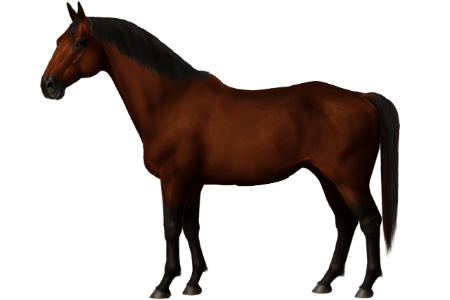 (see the gallery for her younger pictures).
(see the gallery for her younger pictures).
Another one:
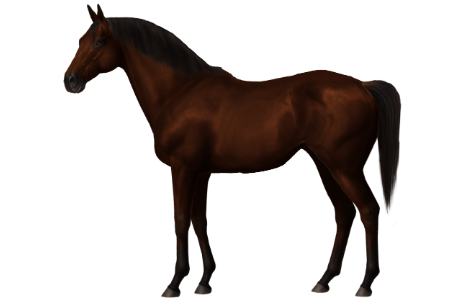
And even a black one:
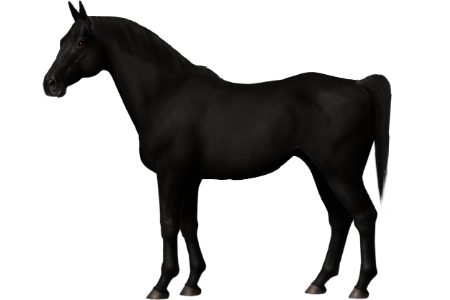
one of them
 (see the gallery for her younger pictures).
(see the gallery for her younger pictures).Another one:

And even a black one:

-
BlackOak2
- Premium

- Posts: 10573
- Joined: Sat Jan 30, 2016 12:41 am
- Visit My Farm
Re: Plume?
Post by BlackOak2 »
In my opinion, it is. Subtle plumes are all over the place, I have it all over my herds... but breeding not for that, but for other genes has not brought it out.Tjigra wrote:I wonder though, I have ended up with several sooty bays with lighter tails and visibly lighter streaks in their manes (before the manes grow out and fall over). Can it be a subtle expression of plume?
(see the gallery for her younger pictures).
...
However... of course... it could also be just foal coloration.
What, from Gaagii's study (again, thank you Gaagii, for undertaking it), what we do know is that when the plume gene is stronger, the foal mane and tails is also stronger. So that is what I'm basing my assumption on. I could be wrong, of course.
Don't forget to check it out!
Quick Start Guide For Newbies
Link to additional information.
BlackOak2's Quick-Links
Quick Start Guide For Newbies
Link to additional information.
BlackOak2's Quick-Links
-
Stick
- Posts: 132
- Joined: Sun May 14, 2017 3:16 pm
- Visit My Farm
Re: Plume?
Post by Stick »
As always, thank you for your in-depth explanation... even when I'm still struggling to follow a few things. 
Another follow-up question to whether the plume mane and/or tail always shows up with fetlock silvering, even over high bay leg markings, is this guy:
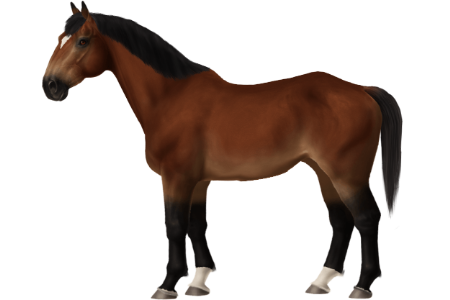
I had labeled him as plume and thought his tail seemed pretty abnormally pale, signalling plume altering his tail along with his mane, but I'm not seeing fetlock silvering? Am I either missing it, or have misidentified the plume in his mane and/or tail? (as usual, his younger picture show things more clearly now that his mane has flopped over)
Another follow-up question to whether the plume mane and/or tail always shows up with fetlock silvering, even over high bay leg markings, is this guy:

I had labeled him as plume and thought his tail seemed pretty abnormally pale, signalling plume altering his tail along with his mane, but I'm not seeing fetlock silvering? Am I either missing it, or have misidentified the plume in his mane and/or tail? (as usual, his younger picture show things more clearly now that his mane has flopped over)
-
BlackOak2
- Premium

- Posts: 10573
- Joined: Sat Jan 30, 2016 12:41 am
- Visit My Farm
Re: Plume?
Post by BlackOak2 »
It certainly does look like plume.Stick wrote:As always, thank you for your in-depth explanation... even when I'm still struggling to follow a few things.
Another follow-up question to whether the plume mane and/or tail always shows up with fetlock silvering, even over high bay leg markings, is this guy:
I had labeled him as plume and thought his tail seemed pretty abnormally pale, signalling plume altering his tail along with his mane, but I'm not seeing fetlock silvering? Am I either missing it, or have misidentified the plume in his mane and/or tail? (as usual, his younger picture show things more clearly now that his mane has flopped over)
The problem with making a study, sometimes is the fact that to accomplish a recessive, difficult gene, is one needs to inbreed to bring it out. The downside to this is the fact that you get to breeding back only one version of that gene.
It's entirely possible that there are things missed. That's why it's better to either work with a couple different lines, or work with a couple different people.
This would be something Gaagii would need to chime in on and give the much more experienced impression on it.
Don't forget to check it out!
Quick Start Guide For Newbies
Link to additional information.
BlackOak2's Quick-Links
Quick Start Guide For Newbies
Link to additional information.
BlackOak2's Quick-Links
Return to “What Colour Is My Horse?”
Jump to
- General Discussion
- ↳ Announcements
- ↳ Weekly Development Updates
- ↳ General Chit Chat
- ↳ Contests
- ↳ What Colour Is My Horse?
- ↳ Comments and Suggestions
- ↳ Suggestions Archive
- ↳ Breeding Communities
- ↳ Farm Logs
- Marketplace
- ↳ Horses for Sale
- ↳ Stallions at Stud
- Knowledgebase & Guides
- ↳ Gameplay Questions & Help
- ↳ Guides & How To
- Technical
- ↳ Change Log v3
- Guest Discussions
- ↳ Public Questions & Answers
